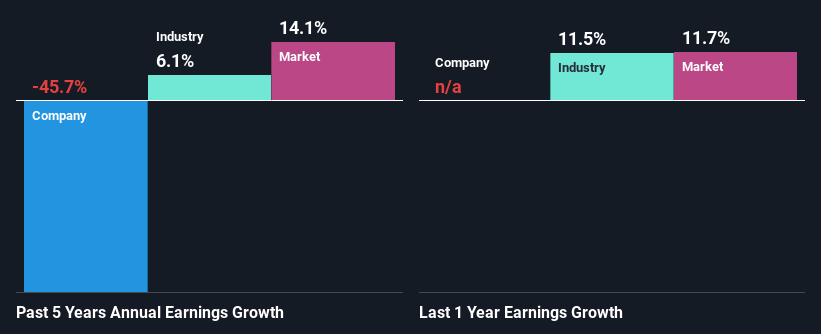- Malaysia
- /
- Wireless Telecom
- /
- KLSE:AXIATA
Axiata Group Berhad (KLSE:AXIATA) Stock's On A Decline: Are Poor Fundamentals The Cause?

It is hard to get excited after looking at Axiata Group Berhad's (KLSE:AXIATA) recent performance, when its stock has declined 3.3% over the past month. To decide if this trend could continue, we decided to look at its weak fundamentals as they shape the long-term market trends. In this article, we decided to focus on Axiata Group Berhad's ROE.
Return on equity or ROE is an important factor to be considered by a shareholder because it tells them how effectively their capital is being reinvested. In other words, it is a profitability ratio which measures the rate of return on the capital provided by the company's shareholders.
View our latest analysis for Axiata Group Berhad
How To Calculate Return On Equity?
Return on equity can be calculated by using the formula:
Return on Equity = Net Profit (from continuing operations) ÷ Shareholders' Equity
So, based on the above formula, the ROE for Axiata Group Berhad is:
2.0% = RM570m ÷ RM28b (Based on the trailing twelve months to June 2024).
The 'return' is the yearly profit. That means that for every MYR1 worth of shareholders' equity, the company generated MYR0.02 in profit.
What Has ROE Got To Do With Earnings Growth?
Thus far, we have learned that ROE measures how efficiently a company is generating its profits. We now need to evaluate how much profit the company reinvests or "retains" for future growth which then gives us an idea about the growth potential of the company. Generally speaking, other things being equal, firms with a high return on equity and profit retention, have a higher growth rate than firms that don’t share these attributes.
A Side By Side comparison of Axiata Group Berhad's Earnings Growth And 2.0% ROE
It is hard to argue that Axiata Group Berhad's ROE is much good in and of itself. Not just that, even compared to the industry average of 11%, the company's ROE is entirely unremarkable. For this reason, Axiata Group Berhad's five year net income decline of 46% is not surprising given its lower ROE. However, there could also be other factors causing the earnings to decline. For instance, the company has a very high payout ratio, or is faced with competitive pressures.
However, when we compared Axiata Group Berhad's growth with the industry we found that while the company's earnings have been shrinking, the industry has seen an earnings growth of 6.1% in the same period. This is quite worrisome.

Earnings growth is a huge factor in stock valuation. The investor should try to establish if the expected growth or decline in earnings, whichever the case may be, is priced in. Doing so will help them establish if the stock's future looks promising or ominous. What is AXIATA worth today? The intrinsic value infographic in our free research report helps visualize whether AXIATA is currently mispriced by the market.
Is Axiata Group Berhad Efficiently Re-investing Its Profits?
Axiata Group Berhad's very high LTM (or last twelve month) payout ratio of 456% over the last three years suggests that the company is paying its shareholders more than what it is earning and this explains the company's shrinking earnings. Its usually very hard to sustain dividend payments that are higher than reported profits. You can see the 2 risks we have identified for Axiata Group Berhad by visiting our risks dashboard for free on our platform here.
Moreover, Axiata Group Berhad has been paying dividends for at least ten years or more suggesting that management must have perceived that the shareholders prefer dividends over earnings growth. Our latest analyst data shows that the future payout ratio of the company is expected to drop to 79% over the next three years. Accordingly, the expected drop in the payout ratio explains the expected increase in the company's ROE to 5.4%, over the same period.
Conclusion
On the whole, Axiata Group Berhad's performance is quite a big let-down. The low ROE, combined with the fact that the company is paying out almost if not all, of its profits as dividends, has resulted in the lack or absence of growth in its earnings. Having said that, looking at current analyst estimates, we found that the company's earnings growth rate is expected to see a huge improvement. Are these analysts expectations based on the broad expectations for the industry, or on the company's fundamentals? Click here to be taken to our analyst's forecasts page for the company.
New: Manage All Your Stock Portfolios in One Place
We've created the ultimate portfolio companion for stock investors, and it's free.
• Connect an unlimited number of Portfolios and see your total in one currency
• Be alerted to new Warning Signs or Risks via email or mobile
• Track the Fair Value of your stocks
Have feedback on this article? Concerned about the content? Get in touch with us directly. Alternatively, email editorial-team (at) simplywallst.com.
This article by Simply Wall St is general in nature. We provide commentary based on historical data and analyst forecasts only using an unbiased methodology and our articles are not intended to be financial advice. It does not constitute a recommendation to buy or sell any stock, and does not take account of your objectives, or your financial situation. We aim to bring you long-term focused analysis driven by fundamental data. Note that our analysis may not factor in the latest price-sensitive company announcements or qualitative material. Simply Wall St has no position in any stocks mentioned.
About KLSE:AXIATA
Axiata Group Berhad
An investment holding company, provides telecommunications services.
Slightly overvalued with questionable track record.
Market Insights
Community Narratives


